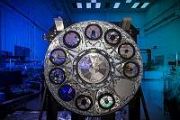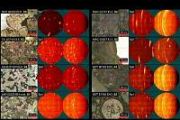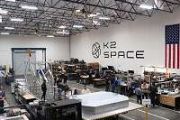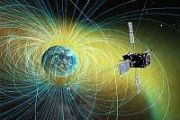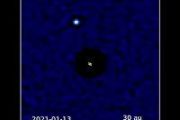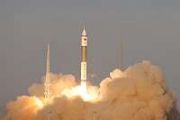
Copernical Team
Giant impact could have formed the Moon more rapidly, scientists reveal in new simulations
 Scientists from Durham University's Institute for Computational Cosmology used the most detailed supercomputer simulations yet to reveal an alternative explanation for the Moon's origin, with a giant impact immediately placing a Moon-like body into orbit around Earth.
The researchers simulated hundreds of different impacts, varying the angle and speed of the collision as well as the masses
Scientists from Durham University's Institute for Computational Cosmology used the most detailed supercomputer simulations yet to reveal an alternative explanation for the Moon's origin, with a giant impact immediately placing a Moon-like body into orbit around Earth.
The researchers simulated hundreds of different impacts, varying the angle and speed of the collision as well as the masses Micro Meat and Orbital Assembly team up on space-based food production venture
 Micro Meat, a pioneer in the alternative protein industry, and Orbital Assembly (OA), developer of space-based business parks with variable gravity, have signed a memorandum of understanding to co-develop cultivated meat production systems in space.
Under the agreement, Micro Meat will install its proprietary meat production equipment aboard OA's Pioneer-classTM space station to provide fo
Micro Meat, a pioneer in the alternative protein industry, and Orbital Assembly (OA), developer of space-based business parks with variable gravity, have signed a memorandum of understanding to co-develop cultivated meat production systems in space.
Under the agreement, Micro Meat will install its proprietary meat production equipment aboard OA's Pioneer-classTM space station to provide fo Viasat and Inmarsat confident their combination benefits consumers
 Viasat Inc. (NASDAQ: VSAT), a global communications company, and Inmarsat, a leading provider of global mobile satellite communications services, remain committed to working with the UK's Competition and Markets Authority (CMA) to demonstrate how their planned transaction will benefit airline, passenger, and enterprise users of In-Flight Connectivity (IFC) in aviation businesses.
"There is
Viasat Inc. (NASDAQ: VSAT), a global communications company, and Inmarsat, a leading provider of global mobile satellite communications services, remain committed to working with the UK's Competition and Markets Authority (CMA) to demonstrate how their planned transaction will benefit airline, passenger, and enterprise users of In-Flight Connectivity (IFC) in aviation businesses.
"There is Exploring Europa possible with silicon-germanium transistor technology
NASA to Practice Artemis Moonwalking, Roving Operations in Arizona Desert
 To prepare for the Artemis era of research on the Moon, NASA will conduct two, multi-week field tests near Flagstaff, Arizona with astronauts, engineers, and scientists to practice mission scenarios for Artemis astronauts in a simulated lunar surface environment.
The Arizona desert possesses many characteristics that are analogous to a lunar environment including challenging terrain, inter
To prepare for the Artemis era of research on the Moon, NASA will conduct two, multi-week field tests near Flagstaff, Arizona with astronauts, engineers, and scientists to practice mission scenarios for Artemis astronauts in a simulated lunar surface environment.
The Arizona desert possesses many characteristics that are analogous to a lunar environment including challenging terrain, inter NASA's InSight waits out dust storm
 NASA's InSight mission, which is expected to end in the near future, saw a recent drop in power generated by its solar panels as a continent-size dust storm swirls over Mars' southern hemisphere. First observed on Sept. 21, 2022, by NASA's Mars Reconnaissance Orbiter (MRO), the storm is roughly 2,175 miles (3,500 kilometers) from InSight and initially had little impact on the lander.
The m
NASA's InSight mission, which is expected to end in the near future, saw a recent drop in power generated by its solar panels as a continent-size dust storm swirls over Mars' southern hemisphere. First observed on Sept. 21, 2022, by NASA's Mars Reconnaissance Orbiter (MRO), the storm is roughly 2,175 miles (3,500 kilometers) from InSight and initially had little impact on the lander.
The m CAPSTONE reports 'Initial Recovery Successful' for lunar orbiter
 Over the past couple of weeks, the CAPSTONE mission team has been working to resolve an anomaly that occurred early last month and resulted in the spacecraft losing full 3-axis attitude control and entering into a spin stabilized state. Through extensive analysis and evaluation supported by a dedicated team of individuals on the mission team and key partners, the most likely cause of the anomaly
Over the past couple of weeks, the CAPSTONE mission team has been working to resolve an anomaly that occurred early last month and resulted in the spacecraft losing full 3-axis attitude control and entering into a spin stabilized state. Through extensive analysis and evaluation supported by a dedicated team of individuals on the mission team and key partners, the most likely cause of the anomaly Chang'e-5 reveals intermediate stage in space weathering process of lunar soil
 This study is conducted by a joint team from Chinese Academy of Sciences. They use aberration-corrected transmission electron microscopy (TEM), Electron-energy loss spectroscopy (EELS) and scanning transmission electron microscopy (STEM) to examine the microstructures and chemical compositions at nano/atomic scales of 25 soil grains (1-3 um in size) from Sample CE5C0400YJFM00507 (1.5 g). The soi
This study is conducted by a joint team from Chinese Academy of Sciences. They use aberration-corrected transmission electron microscopy (TEM), Electron-energy loss spectroscopy (EELS) and scanning transmission electron microscopy (STEM) to examine the microstructures and chemical compositions at nano/atomic scales of 25 soil grains (1-3 um in size) from Sample CE5C0400YJFM00507 (1.5 g). The soi NASA's Crew-5 mission casts long exposure light beam
 In this 20-second exposure from Oct. 5, 2022, a SpaceX Falcon 9 rocket carrying the company's Crew Dragon spacecraft is launched on NASA's SpaceX Crew-5 mission from our Kennedy Space Center in Florida to the International Space Station (ISS).
This is the fifth crew rotation mission of the SpaceX Crew Dragon spacecraft and Falcon 9 rocket to the ISS as part of the agency's Commercial Crew
In this 20-second exposure from Oct. 5, 2022, a SpaceX Falcon 9 rocket carrying the company's Crew Dragon spacecraft is launched on NASA's SpaceX Crew-5 mission from our Kennedy Space Center in Florida to the International Space Station (ISS).
This is the fifth crew rotation mission of the SpaceX Crew Dragon spacecraft and Falcon 9 rocket to the ISS as part of the agency's Commercial Crew Rocket Lab successfully launches 31st Electron rocket
 Rocket Lab USA, Inc. (Nasdaq: RKLB) has broken its annual launch record with the launch of "It Argos Up From Here," a dedicated launch for General Atomics Electromagnetic Systems (GA-EMS). The mission was Rocket Lab's 31st Electron launch overall and the eighth for the year to date, besting the company's previous record of seven launches in 2020. Rocket Lab has now successfully launched a missio
Rocket Lab USA, Inc. (Nasdaq: RKLB) has broken its annual launch record with the launch of "It Argos Up From Here," a dedicated launch for General Atomics Electromagnetic Systems (GA-EMS). The mission was Rocket Lab's 31st Electron launch overall and the eighth for the year to date, besting the company's previous record of seven launches in 2020. Rocket Lab has now successfully launched a missio 
















